Experimental Investigation of Natural Lighting Systems Using Cylindrical Glass for Energy Saving in Buildings
Abstract
:1. Introduction
2. Materials and Methods
2.1. Testing Model Design, Temperature, and Illuminant Measurements under Controlled Conditions
2.2. Testing the Boxes’ Thermal Behaviors and Illuminant Measurements under Natural Light and Weather Conditions
3. Results and Discussion
3.1. Surface Temperatures on the Top and Internal Temperatures of Each Model under Controlled Conditions
3.2. Indoor Illuminance under Controlled Conditions
3.3. Comparison of Thermal Behavior and Inside Illuminance under Natural Weather Conditions
3.3.1. Surface Temperature Fluctuation
3.3.2. Temperature Gradient
3.3.3. Indoor Space Temperature and Illuminance
4. Conclusions
Author Contributions
Funding
Acknowledgments
Conflicts of Interest
References
- Ürge-Vorsatz, D.; Cabeza, L.F.; Serrano, S.; Barreneche, C.; Petrichenko, K. Heating and cooling energy trends and drivers in buildings. Renew. Sustain. Energy Rev. 2015, 41, 85–98. [Google Scholar] [CrossRef] [Green Version]
- Ürge-Vorsatz, D.; Petrichenko, K.; Staniec, M.; Eom, J. Energy use in buildings in a long-term perspective. Curr. Opin. Environ. Sustain. 2013, 5, 141–151. [Google Scholar] [CrossRef]
- Caicedo, D.; Pandharipande, A.; Willems, F.M. Daylight-adaptive lighting control using light sensor calibration prior-information. Energy Build. 2014, 73, 105–114. [Google Scholar] [CrossRef]
- Doulos, L.T.; Sioutis, I.; Tsangrassoulis, A.; Canale, L.; Faidas, K. Revision of threshold luminance levels in tunnels aiming to minimize energy consumption at no cost: Methodology and case studies. Energies 2020, 13, 1707. [Google Scholar] [CrossRef] [Green Version]
- Alrubaih, M.S.; Zain, M.F.M.; Alghoul, M.A.; Ibrahim, N.L.N.; Shameri, M.A.; Elayeb, O. Research and development on aspects of daylighting fundamentals. Renew. Sustain. Energy Rev. 2013, 21, 494–505. [Google Scholar] [CrossRef]
- Yoo, S.; Kim, J.; Jang, C.Y.; Jeong, H. A sensor-less LED dimming system based on daylight harvesting with BIPV systems. Opt. Express 2014, 22, A132–A143. [Google Scholar] [CrossRef]
- Saxena, R.; Biplab, K.; Rakshit, D. Quantitative assessment of phase change material utilization for building cooling load abatement in composite climatic condition. J. Sol. Energy Eng. 2017, 140, 1–15. [Google Scholar] [CrossRef]
- Kim, I.T.; Kim, Y.S.; Cho, M.; Nam, H.; Choi, A.; Hwang, T. High-performance accuracy of daylight-responsive dimming systems with illuminance by distant luminaires for energy-saving buildings. Energies 2019, 12, 731. [Google Scholar] [CrossRef] [Green Version]
- Kim, C.H.; Kim, K.S. Development of sky luminance and daylight illuminance prediction methods for lighting energy saving in office buildings. Energies 2019, 12, 592. [Google Scholar] [CrossRef] [Green Version]
- Freewan, A.A.Y. Impact of external shading devices on thermal and daylighting performance of offices in hot climate regions. Sol. Energy 2014, 102, 14–30. [Google Scholar] [CrossRef]
- Berardi, U.; Wang, W. Daylighting in an atrium-type high performance house. Build. Environ. 2014, 76, 92–104. [Google Scholar] [CrossRef]
- Kwon, C.W.; Lee, K.J. Integrated daylighting design by combining passive method with daysim in a classroom. Energies 2018, 11, 3168. [Google Scholar] [CrossRef] [Green Version]
- Kaminska, A.; Ożadowicz, A. Lighting control including daylight and energy efficiency improvements analysis. Energies 2018, 11, 2166. [Google Scholar] [CrossRef] [Green Version]
- Lee, K.S.; Han, K.J.; Lee, J.W. The impact of shading type and azimuth orientation on the daylighting in a classroom–focusing on effectiveness of façade shading, comparing the results of DA and UDI. Energies 2017, 10, 635. [Google Scholar] [CrossRef] [Green Version]
- Van der Rhee, H.J.; de Vries, E.; Coebergh, J.W. Regular sun exposure benefits health. Med. Hypotheses 2016, 97, 34–37. [Google Scholar] [CrossRef]
- Leslie, R.P. Capturing the daylight dividend in buildings: Why and how? Build. Environ. 2003, 38, 381–385. [Google Scholar] [CrossRef]
- Kechichian, E.; Ezzedine, K. Vitamin D and the Skin: An Update for Dermatologists. Am. J. Clin. Dermatol. 2018, 19, 223–235. [Google Scholar] [CrossRef]
- Valles, X.; Alonso, M.H.; Lopez-Caleya, J.F.; Diez-Obrero, V.; Dierssen-Sotos, T.; Lope, V.; Molina-Barcelo, A.; Chirlaque, M.D.; Jimenez-Moleon, J.J.; Tardon, G.F.; et al. Colorectal cancer, sun exposure and dietary vitamin D and calcium intake in the MCC-Spain study. Environ. Int. 2018, 121, 428–434. [Google Scholar] [CrossRef]
- Kim, J.T.; Kim, G. Overview and new developments in optical daylighting systems for building a healthy indoor environment. Build. Environ. 2010, 45, 256–269. [Google Scholar] [CrossRef]
- Pandharipande, A.; Caicedo, D. Daylight integrated illumination control of LED systems based on enhanced presence sensing. Energy Build. 2011, 43, 944–950. [Google Scholar] [CrossRef]
- Musumeci, S.; Bojoi, R.; Armando, E.; Borlo, S.; Mandrile, F. Three-legs interleaved boost power factor corrector for high-power LED lighting application. Energies 2020, 13, 1728. [Google Scholar] [CrossRef] [Green Version]
- Cannavale, A.; Ayr, U.; Fiorito, F.; Martellotta, F. Smart electrochromic windows to enhance building energy efficiency and visual comfort. Energies 2020, 13, 1449. [Google Scholar] [CrossRef] [Green Version]
- Acosta, I.; Campano, M.Á.; Amarillo, S.D.; Muñoz, C. Dynamic daylight metrics for electricity savings in offices: Window size and climate smart lighting management. Energies 2018, 11, 3143. [Google Scholar] [CrossRef] [Green Version]
- Galatioto, A.; Beccali, M. Aspects and issues of daylighting assessment: A review study. Renew. Sustain. Energy Rev. 2016, 66, 852–860. [Google Scholar] [CrossRef]
- Sibley, M. Let There Be Light! Investigating Vernacular Daylighting in Moroccan Heritage Hammams for Rehabilitation, Benchmarking and Energy Saving. Sustainability 2018, 10, 3984. [Google Scholar] [CrossRef] [Green Version]
- Baglivo, C.; Bonomolo, M.; Congedo, P.M. Modeling of light pipes for the optimal disposition in buildings. Energies 2019, 12, 4323. [Google Scholar] [CrossRef] [Green Version]
- Chylek, P.; Lesins, G.B.; Videen, G.; Wong, J.G.D.; Pinnick, R.G.; Ngo, D.; Klett, J.D. Black carbon and absorption of solar radiation by clouds. J. Geophys. Res. Atmos. 1996, 101, 23365–23371. [Google Scholar] [CrossRef]
- Zhang, Q.; Thompson, J.E. A model for absorption of solar radiation by mineral dust within liquid cloud drops. J. Atmos. Solar Terres. Phys. 2015, 133, 121–128. [Google Scholar] [CrossRef]
- Maneewan, S.; Janyoosuk, K.; Chan, H.Y.; Thongtha, A. Incorporating black dust into autoclaved aerated concrete wall for heat transfer reduction. J. Metals Mater. Miner. 2019, 29, 82–87. [Google Scholar]
- Thongtha, A.; Khongthon, A.; Boonsri, T.; Chan, H.Y. Thermal effectiveness enhancement of autoclaved aerated concrete wall with PCM-contained conical holes to reduce the cooling load. Materials 2019, 12, 2170. [Google Scholar] [CrossRef] [Green Version]
- Punlek, C.; Maneewan, S.; Thongtha, A. Phase change material coating on autoclaved aerated lightweight concrete for cooling load reduction. Mater. Sci. (MEDŽIAGOTYRA) 2017, 23, 145–149. [Google Scholar] [CrossRef] [Green Version]



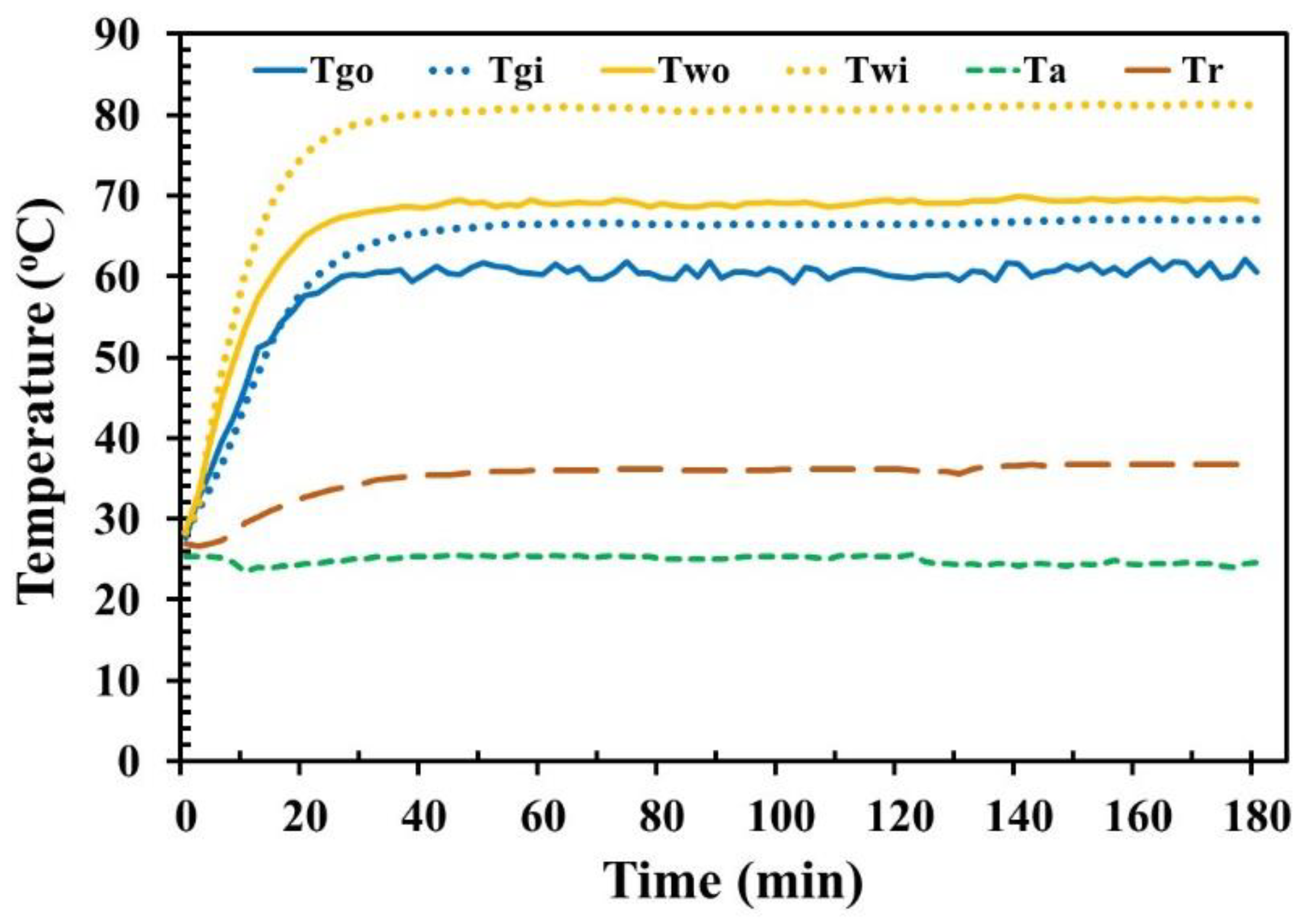
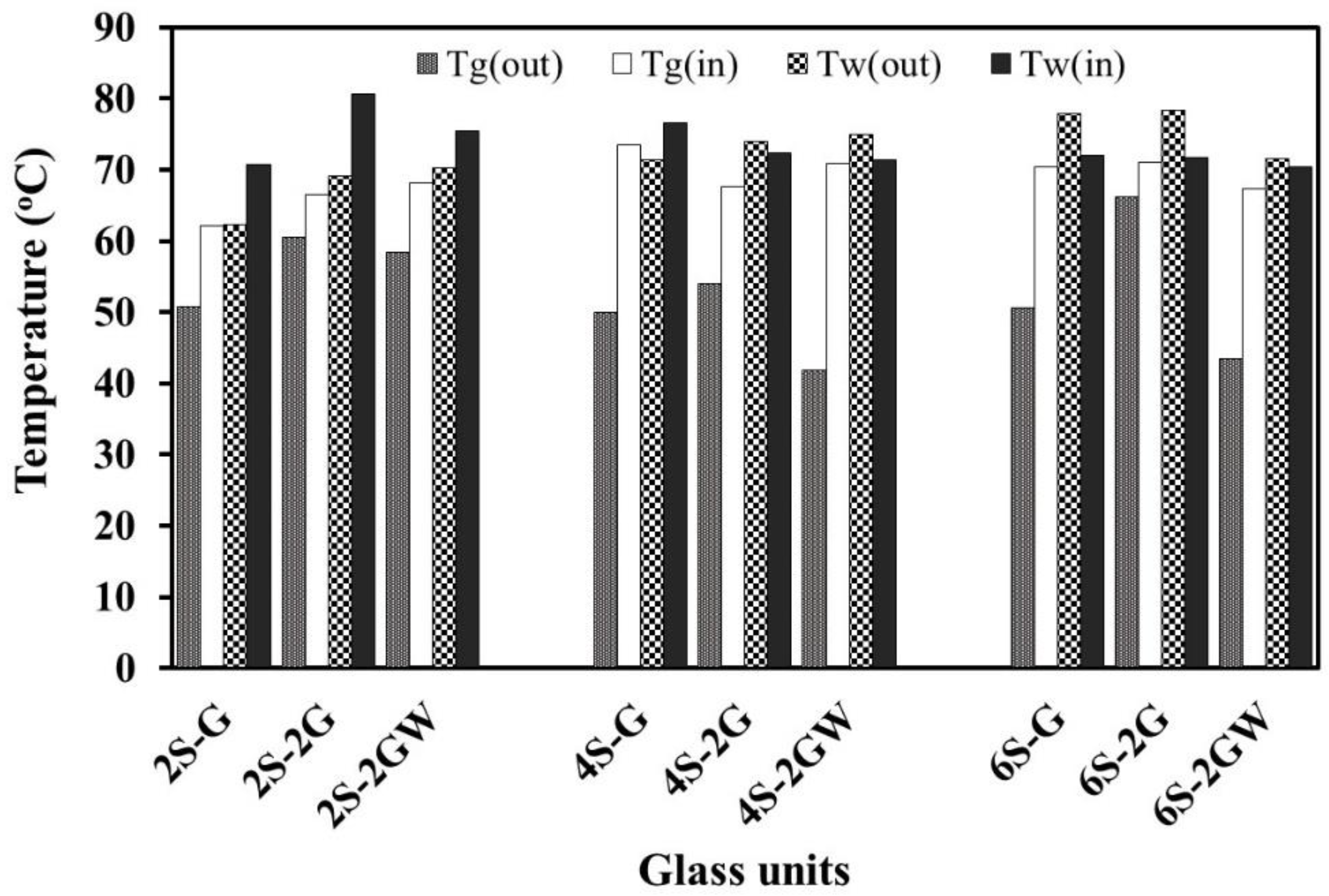
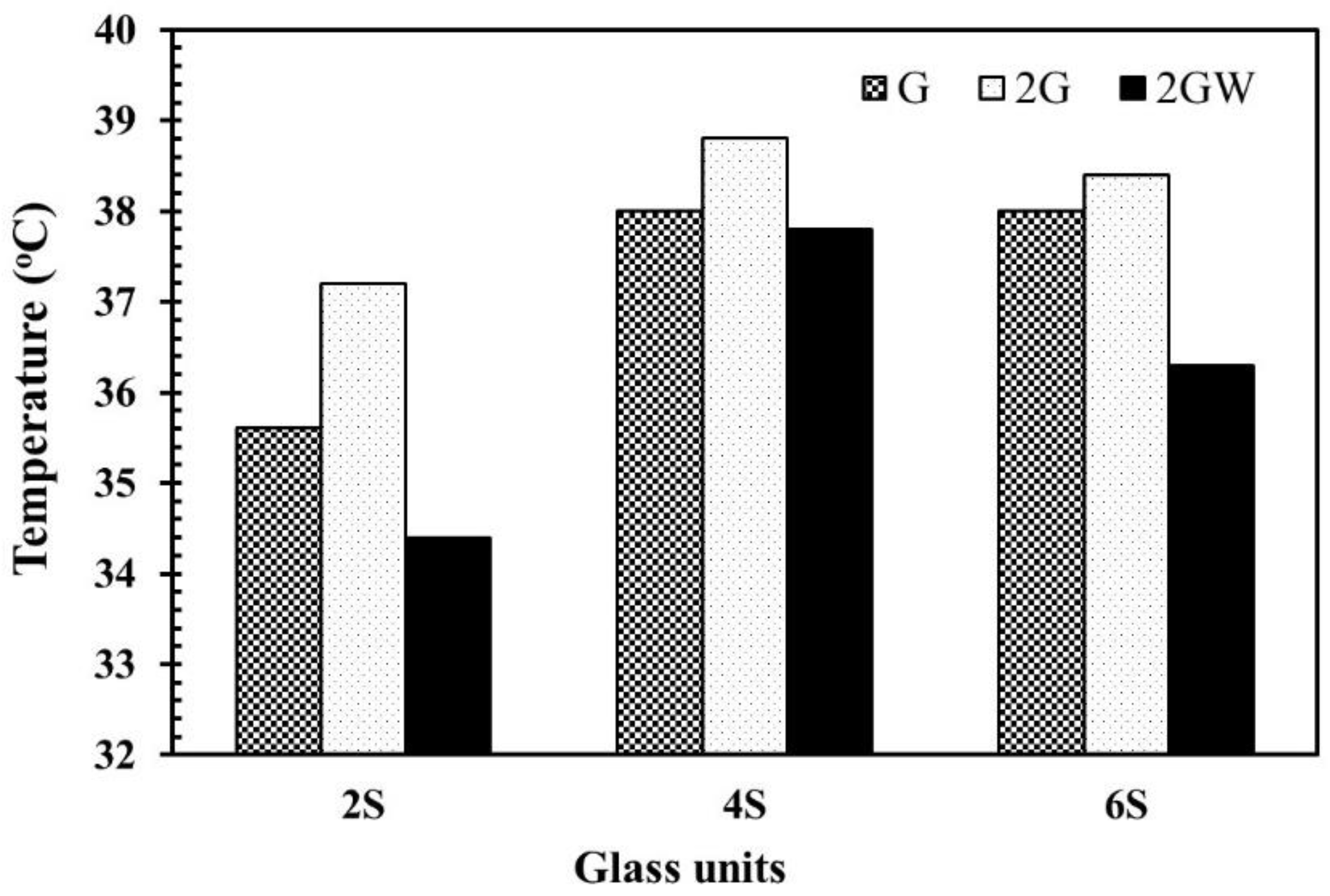
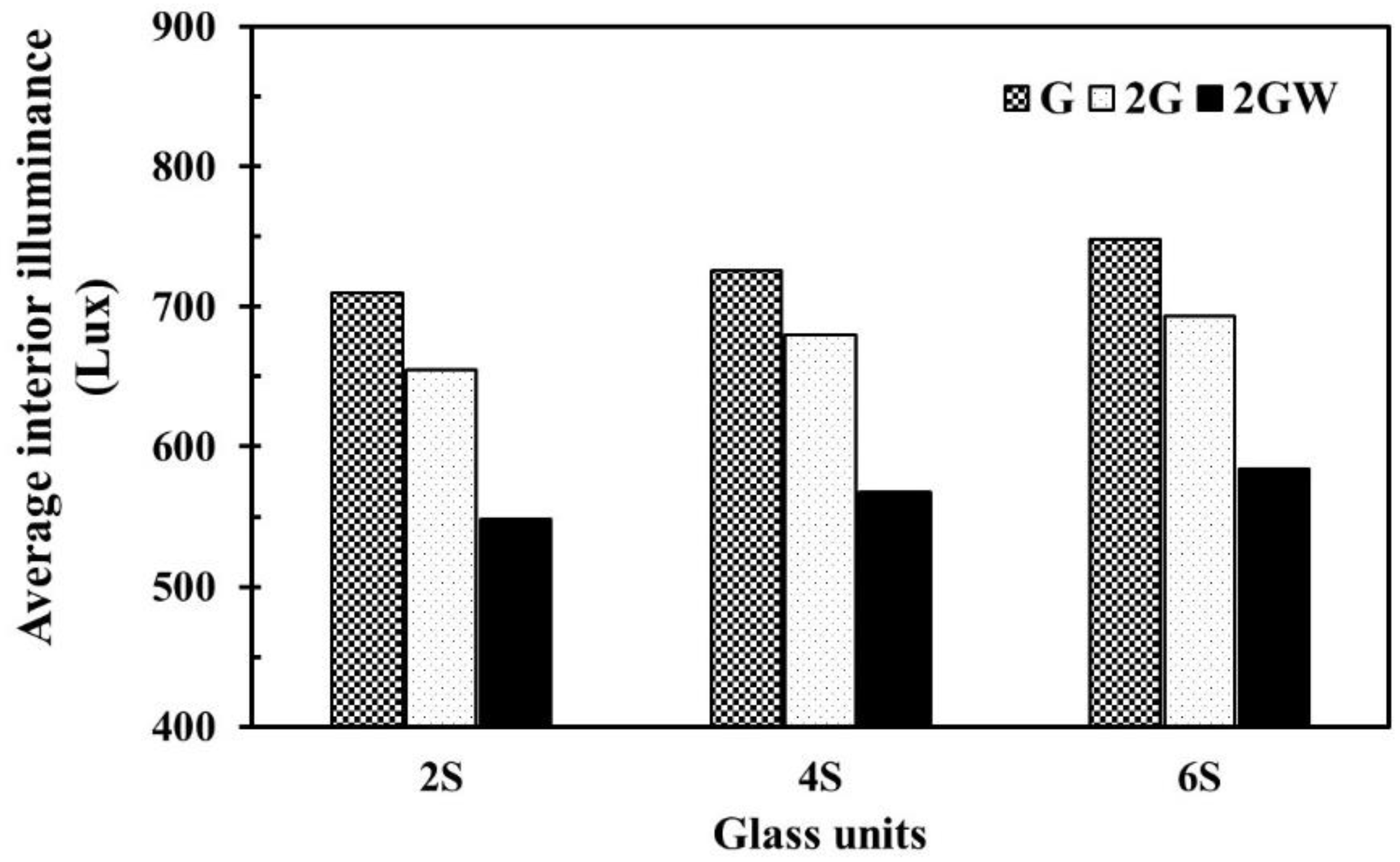
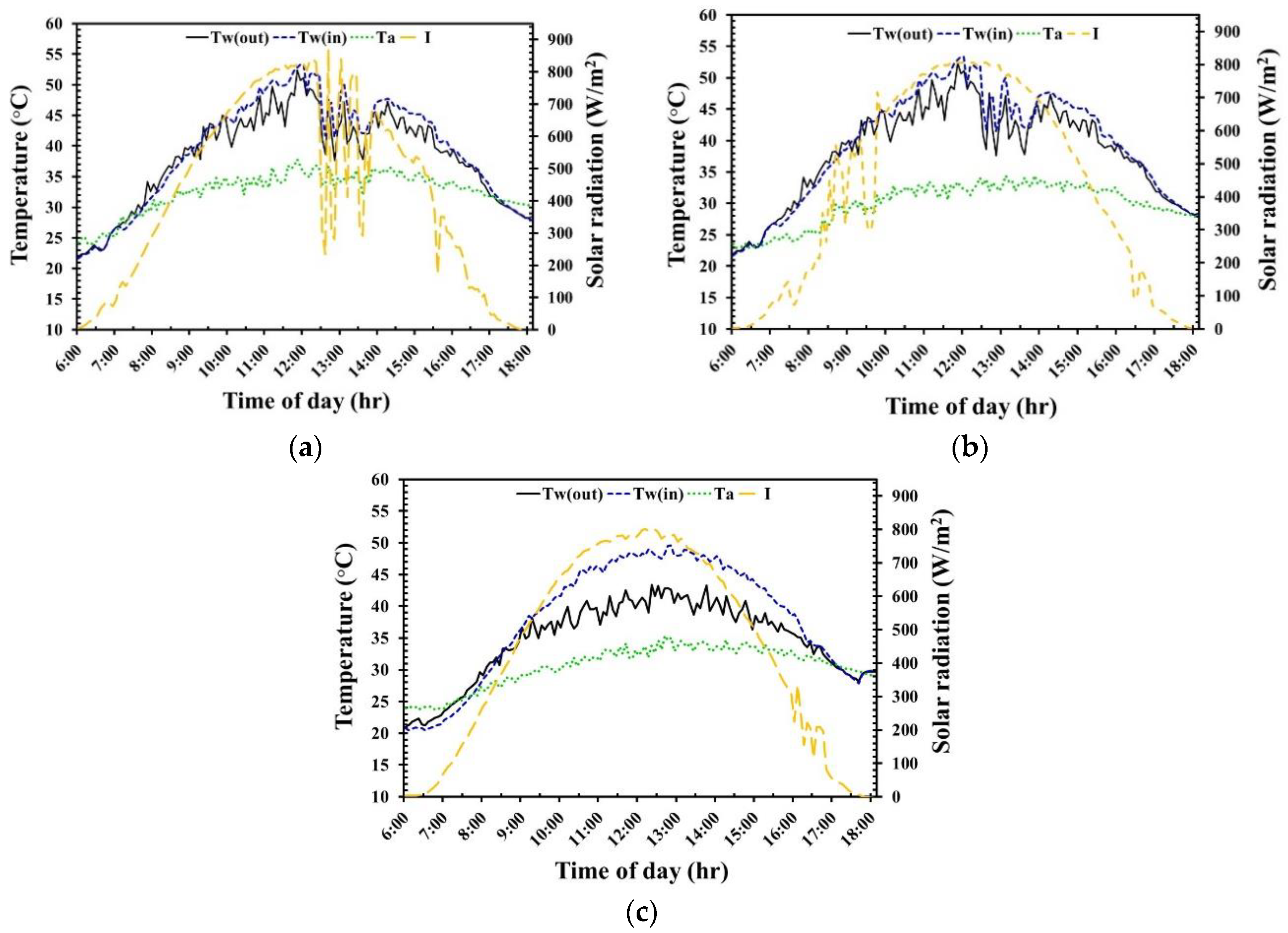
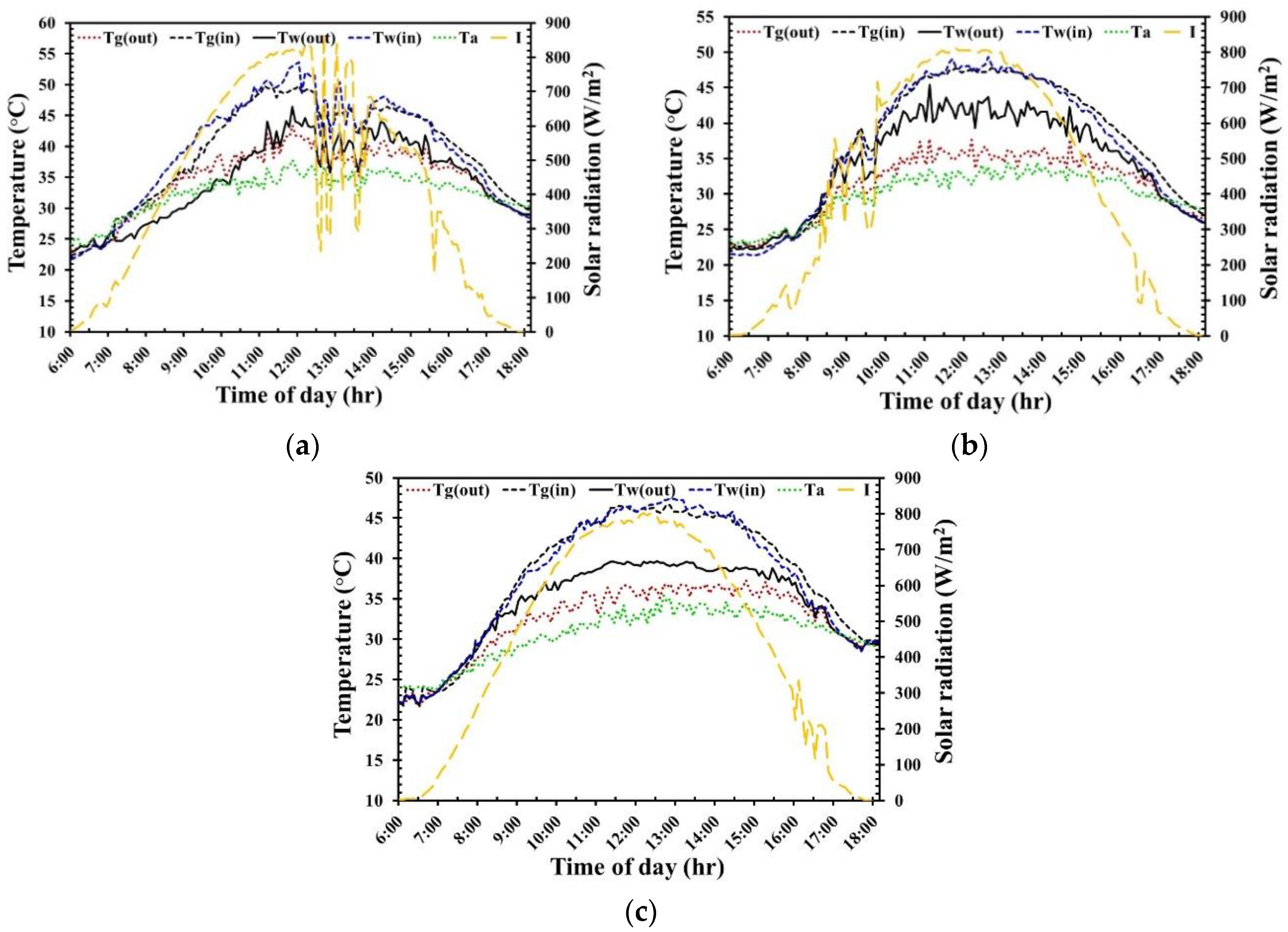
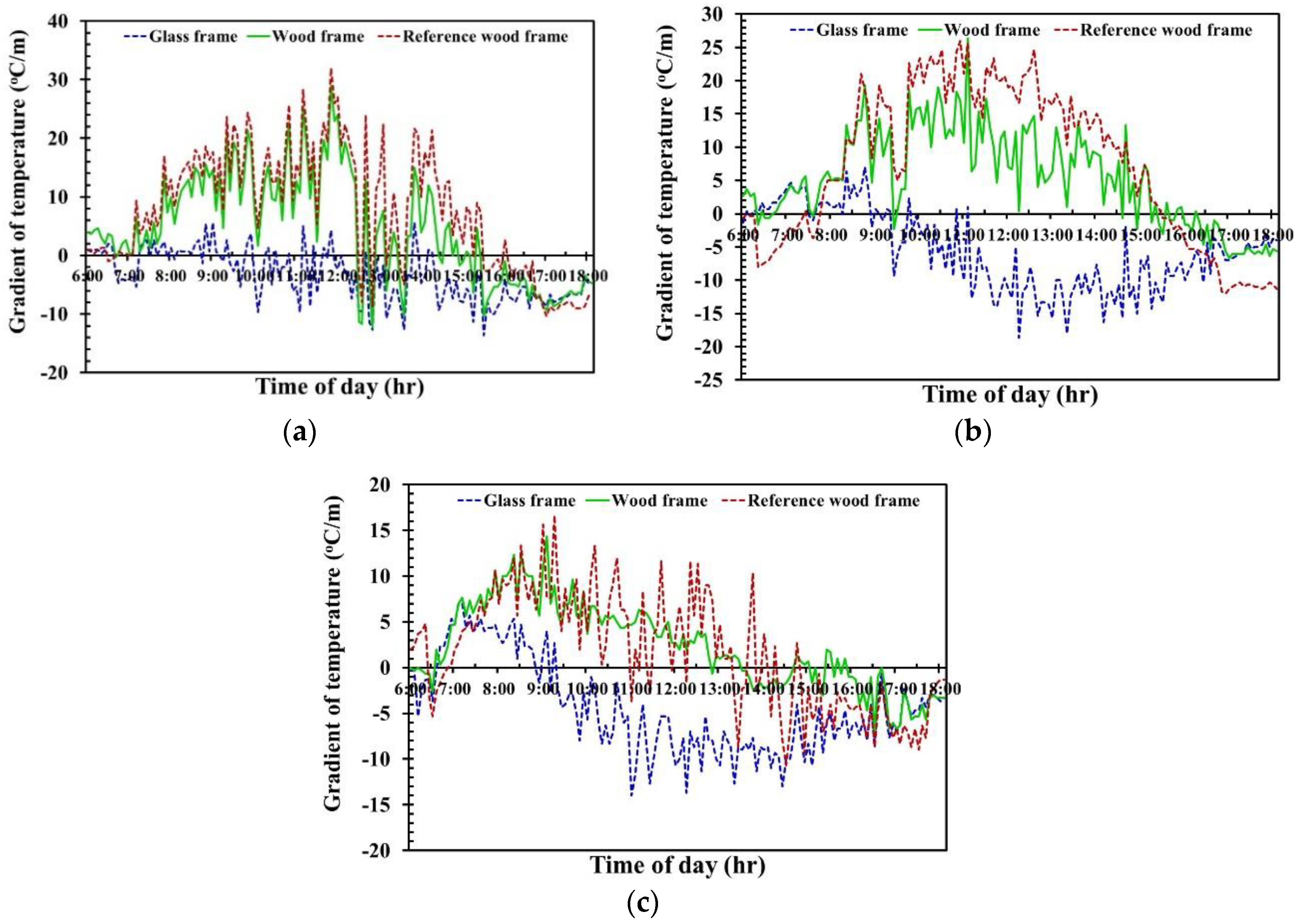
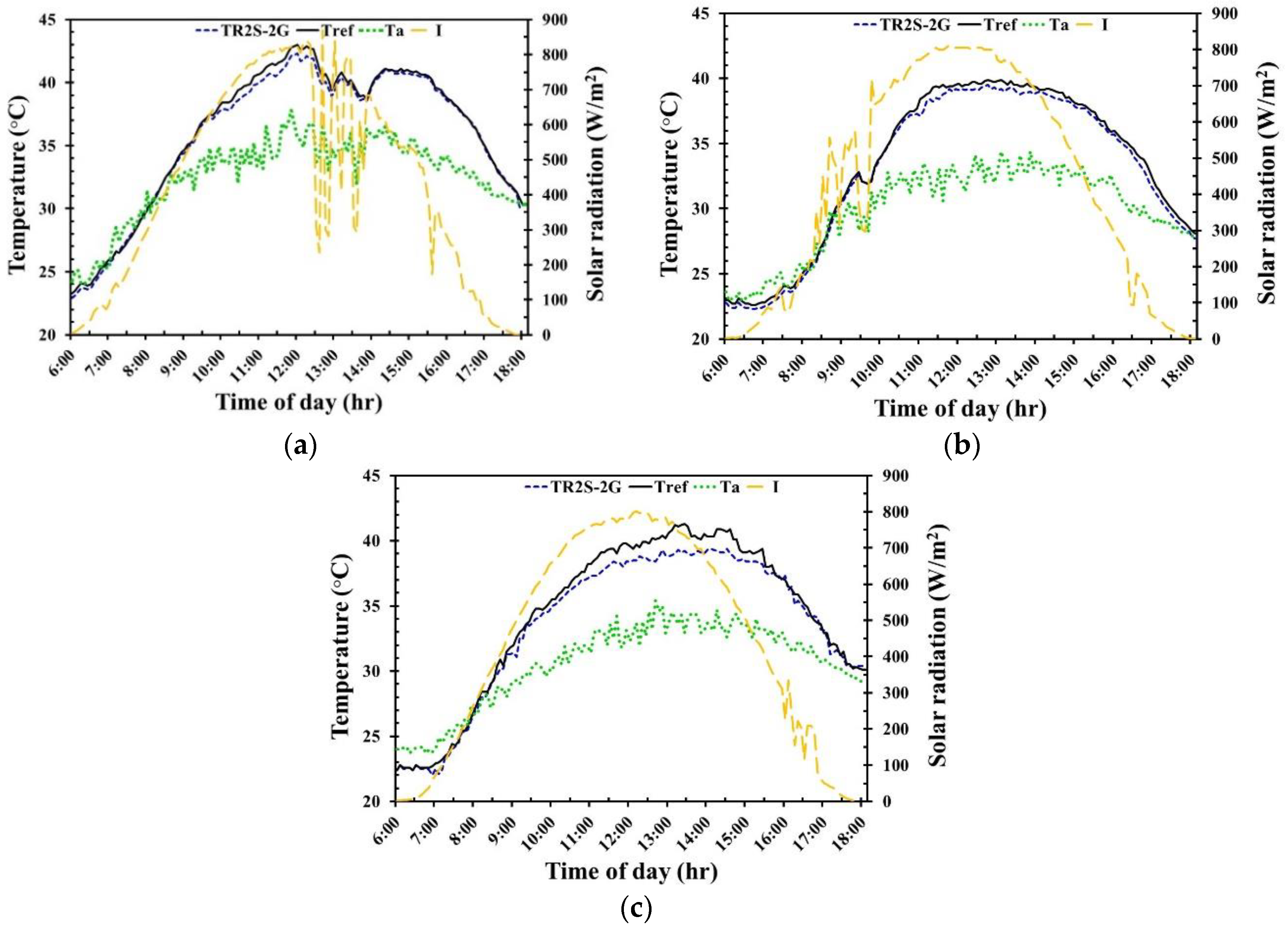
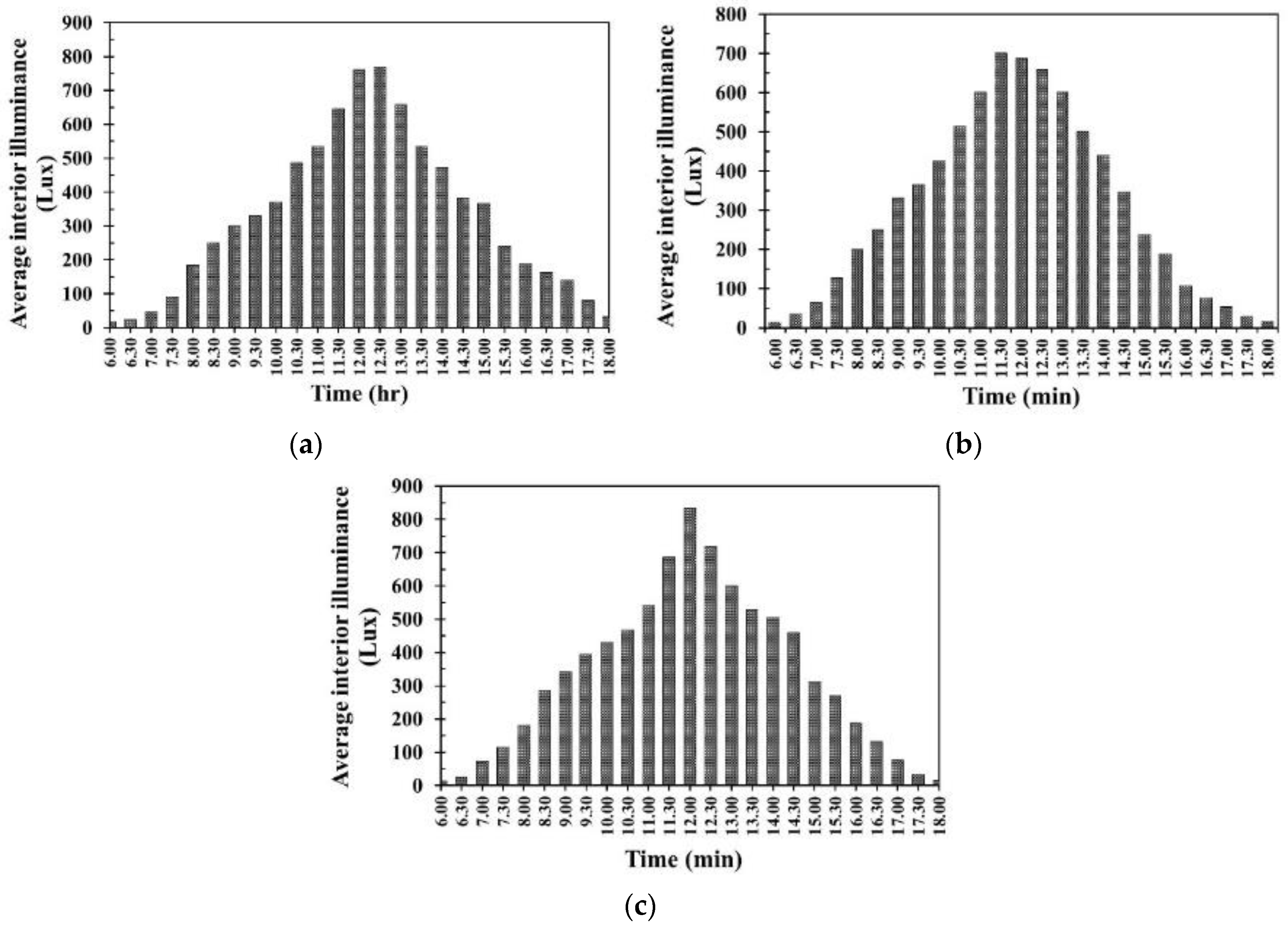
| Day | Type of Model | |||||||||
|---|---|---|---|---|---|---|---|---|---|---|
| Reference | 2S-2GW | |||||||||
| Two (°C) | Twi (°C) | Tr (°C) | Ta (°C) | Two (°C) | Twi (°C) | Tgo (°C) | Tgi (°C) | Tr (°C) | Ta (°C) | |
| 1st | 52.4 | 53.3 | 43.0 | 37.8 | 46.4 | 53.6 | 43.4 | 49.8 | 42.3 | 37.8 |
| 2nd | 47.0 | 49.3 | 39.9 | 34.4 | 45.4 | 49.3 | 37.8 | 47.8 | 39.5 | 34.4 |
| 3rd | 43.4 | 49.6 | 41.3 | 35.3 | 39.7 | 47.4 | 37.3 | 46.7 | 39.4 | 35.3 |
| Avg. | 47.6 | 50.7 | 41.4 | 35.8 | 43.8 | 50.1 | 39.5 | 48.1 | 40.4 | 35.8 |
| Day | Type of Model | |||||||||
|---|---|---|---|---|---|---|---|---|---|---|
| Reference | 2S-2GW | |||||||||
| Two (°C) | Twi (°C) | Tr (°C) | Ta (°C) | Two (°C) | Twi (°C) | Tgo (°C) | Tgi (°C) | Tr (°C) | Ta (°C) | |
| 1st | 39.4 | 40.6 | 37.1 | 33.2 | 35.7 | 41.0 | 35.7 | 40.5 | 36.7 | 33.2 |
| 2nd | 34.9 | 36.1 | 33.1 | 29.8 | 34.1 | 36.4 | 31.1 | 36.8 | 32.7 | 29.8 |
| 3rd | 34.7 | 37.7 | 34.3 | 30.6 | 34.3 | 37.3 | 32.3 | 37.7 | 33.6 | 30.6 |
| Avg. | 36.3 | 38.1 | 34.8 | 31.2 | 34.7 | 38.2 | 33.0 | 38.3 | 34.3 | 31.2 |
© 2020 by the authors. Licensee MDPI, Basel, Switzerland. This article is an open access article distributed under the terms and conditions of the Creative Commons Attribution (CC BY) license (http://creativecommons.org/licenses/by/4.0/).
Share and Cite
Thongtha, A.; Boontham, P. Experimental Investigation of Natural Lighting Systems Using Cylindrical Glass for Energy Saving in Buildings. Energies 2020, 13, 2528. https://doi.org/10.3390/en13102528
Thongtha A, Boontham P. Experimental Investigation of Natural Lighting Systems Using Cylindrical Glass for Energy Saving in Buildings. Energies. 2020; 13(10):2528. https://doi.org/10.3390/en13102528
Chicago/Turabian StyleThongtha, Atthakorn, and Piromporn Boontham. 2020. "Experimental Investigation of Natural Lighting Systems Using Cylindrical Glass for Energy Saving in Buildings" Energies 13, no. 10: 2528. https://doi.org/10.3390/en13102528
APA StyleThongtha, A., & Boontham, P. (2020). Experimental Investigation of Natural Lighting Systems Using Cylindrical Glass for Energy Saving in Buildings. Energies, 13(10), 2528. https://doi.org/10.3390/en13102528




